I stopped by the “Alumni of 1801” exhibit on Friday and saw another fabulous exhibition. (See posts one and two about my previous exhibition/studio visit to 1801 in the Spring.) You can see more photos from my trip to 1801 Howard St. on my flickr page.
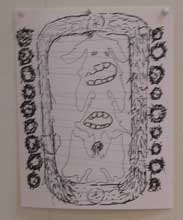
1801 Howard is the artists’ live/work space at the corner of Howard and Montgomery Streets in Kensington. This alumni exhibit includes names that are a who’s who list of Philadelphia contemporary art: Tristin Lowe, Shannon Bowser, Clint Takeda, Joy Feasley and Paul Swenbeck, Sue Patterson, Kait Midgette, Kate Brockman, David Wickland — many Fleisher Challenge winners and a Pew fellow.
Much of the work in the show is new, and, in keeping with the communal spirit of the place, lots of the work is collaborative. There’s a wall of collaborative drawings; and a collaborative painting by Clint Takeda and Paul Swenbeck.
(image is one of the group collaborative drawings)
The raw, alternative space has been cleaned up and the art look good here. This type of space is perfect for experimental work in fact and much of the work in the show feels like it’s reaching and experimenting. Go to one of the closing receptions (Oct. 16 and 17, 3 pm-til all day) and you’ll probably get live music as well — Bardo Pond members live and lived at 1801 Howard, and they played at the opening reception.
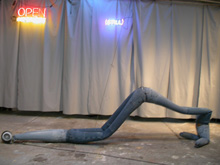
Speaking of the opening, Mike McJilton, one of the current 1801ers who helped organize the show along with Jon Reeb said the opening was attended by some 250 folks and that in addition to Bardo Pond, Shannon Bowser had a three-piece combo that played. (Bowser plays drums, Richard Harrod was also in the combo and I’m sorry but I forget the third band member’s name.) The band’s name is a string of initials, said McJilton, who couldn’t quite remember the alphabetic array.
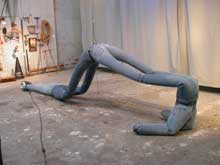
The gang put up a curtain to cordon off some of the space and it’s probably serendipitous but the curtain is so theatrical it’s the perfect backdrop Tristin Lowe‘s new piece, “Jean-nome,” a blue jeans inflatable (there’s a fan blowing air into the piece). “Jean-nome” is a perfect performer in front of the curtain. The ground-hugging piece is sly and demure. You almost don’t see it until you see it and then you can’t take your eyes off it.
(images above and below are of Lowe’s piece before curtain and under Sue Patterson‘s neon work or seemingly bowing down before Patterson’s wall of tools)
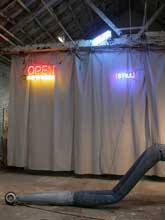
The blue jean coupler has so many allusive references I don’t know where to begin. In addition to the title’s reference to the human genome (and the subtext of genetic mutation, genetic engineering and cloning and all the rest) the piece’s visuals evoke praying mantis, yoga moves, Cirque du Soleil and kama sutra. They’re loaded little hot pants!
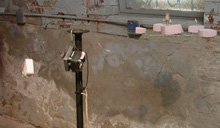
Shannon Bowser‘s two mechanized pieces are another high point. In “Ice Flow” a moter sets small, pink, icecube-like concrete chunks to shimmying like morsels from a stone age refrigerator.
(image right is detail of “Ice Flow”)
Bowser’s other piece, this one triggered by a motion-sensing device, is a metal spoon-like object attached to some wires. The piece swings wildly when you approach. It’s the epitome of passive-aggressive.
(image below is McJilton triggering Bowser‘s motion-sensitive piece. In the background are sculptural works on a wall (maybe by Takeda? or Swenbeck? — sorry, my note-taking was a little off) and the collaborative painting by Takeda and Swenbeck)
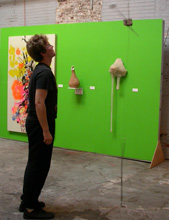
Sue Patterson showed the historical range of her work with a wall of tools and her new neon sign work made in collaboration with Eileen Garrett.
(image below is Patterson’s tool wall. Above are the images of the neon signs)
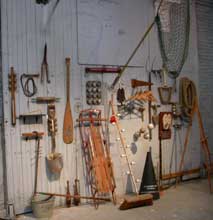
McJilton told me that the collaborative painting by Takeda and Swenbeck was done with the use of a projector. Somehow projecting light and image as a technique for making a collaborative work fits for two artists whose works are about emanations of monsters and witches.
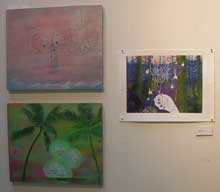
In the midst of the experimental works is a bronze (I believe) statue of a nude female by Kate Brockman, a PAFA graduate who was at the Academy at the same time 1801ers John Gibbons and Isobel Sollenberger were there. I’m sorry I don’t have a photo. The figurative piece is a reminder of the range of art being made in the city.
There’s a wall of works by Joy Feasley and by Brooklyn-based David Wickland who lived at 1801 some 7 years ago.
(image above is three Feasley works)
Kait Midgette had a nice furniture piece with a peephole environment hidden inside. The light mechanism wasn’t working to reveal what was inside the peephole but Gibbons had a flashlight so I got a glimpse of what looks like a miniature bedroom inside. Lost and forlorn is the affect. (sorry, I didn’t take a photo)
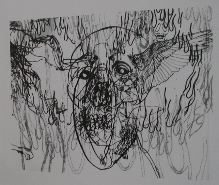
And on the way into and out of the space, a couple of Lowe drawings that are a surprise. They had that satanic emanation thing going on that reminded me of the heavy metal show “scarab” that some of these folks participated in at Project Room a few years back.
(image is a Lowe drawing).
And of course, it must be mentioned that almost all these alumni have ties to Vox Populi and to Project Room, two other hotbeds of young collaborative art in Philadelphia. (Midgette’s Project Room is no more, alas).
That’s it for this post. I have more about the studio visit I did with John Gibbons and Takatomo Tomita who are collaborating on some film work. I’ll address that in a separate post.
If you can’t make the closing receptions but want to see the show, email Mike — mmcjilton@artistsof1801.com — or call Mike 757-710-3852 or Jon Reeb 267-240-9682.
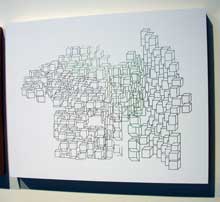
Finally, I want to tell you this story before leaving the 1801 scene which I can’t recommend highly enough. I was met at the door by Brendan Finney, a newcomer to Philadelphia from Montana. Finney said excuse his scruffy clothes, he just got off work installing windows for a small company that hand-makes its windows and installs them (no Anderson for them). Finney is not a visual artist he said, but he’s a writer, a poet who in fact has written about art (I said he should write for artblog — poets make great writers about art). Finney’s story is that after college he and an artist friend of his who had some acquaintance with Philadelphia decided they wanted some urban experience. Because of the friend’s experience of Philadelphia (maybe he had a friend here) the two moved from Montana. Just like that. I mention this as a networking story and as a story about all the young immigrants flowing back and forth around the country and hooking in to affinity networks. Philadelphia is definitely on young peoples’ radars as a good place for artists.
(last image is work by David Wickland. It’s metallic tape (maybe the tape used to mask out areas on slides) on painted board I believe)









